Cheese Soufflé: Light as a Feather and Full of Flavour
Cheese soufflé is one of the most unique and fun dishes for breakfast. Whether you’re a seasoned fan, a sweet soufflé addict, or just hearing about it for the first time, you will love reading this blog. Discover the fascinating process that makes the egg mix rise and fill with air, learn about various kinds of soufflé you can find, and explore all the cheeses that can be used in it. So prepare to dream about airy cheesy dishes, and read on!
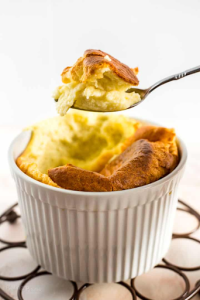 Soufflé with brie (Plating Pixels)
Soufflé with brie (Plating Pixels)
What Is Soufflé? How Is It Made?
First and foremost, let’s take a look at the concept. It is a baked egg-based dish originating from France. As the name “soufflé” (“airy” or “inflated” in French) suggests, it has a light texture and is filled with air. But how do they make it?
Actually, its preparation is rather difficult. It has a base of cream, whether a sweet custard or a savoury crème béchamel. But the magic ingredient is the egg whites, beaten until their consistency turns into stiff peaks (i.e., when the egg whites are smooth, moist, shiny, and the tips can stand straight up).
Once poured into a special ceramic bowl, the mix is put in a high-temperature oven. Over the course of the baking, the high heat of the oven makes the liquid of the mix evaporate. The air released by the evaporation makes the egg whites rise while staying trapped inside the mix instead of getting released, thus resulting in the soufflé’s airy consistency.
There are other challenges involved in its preparation. Once taken out of the oven, the air only stays inside the soufflé for about twenty minutes. After that, you will notice the soufflé flatten and lose the air inside. That isn’t quite the experience you were going for, right? On top of that, a soufflé is only really feasible when baked in small ceramic bowls, in which the temperature is equal throughout the entire dish. Try making a soufflé in a large bowl. The heat will be unevenly distributed, and it will not rise the same way everywhere.

Chocolate soufflé (Home Cooking Adventure)
There are three general categories of soufflés available:
-
Sweet:
The classic egg mix with sweet sauce and added chocolate or fruit sauce
-
Frozen:
The same sweet soufflé, but frozen for a couple of hours after baking - Savoury: Made with savoury sauce and vegetables, ham, chicken, seafood or cheese, which is what we will concentrate on today
A sweet soufflé may be served alone or with a side of ice cream, fruit or sauce on the side.
Cheese Soufflé Around the World
While the original French cheese soufflé recipes called for parmesan or gruyère, these days, you can use any kind of cheese: Comté, Vacherin, Fourme, Roquefort, even Kraft Singles or La Vache qui rit, if you want to!
The cheese also depends on the country. Each country makes a soufflé using their local cheese:

French version (Eat, Live, Travel, Write)
-
France, the country with the oldest soufflé tradition:
Roquefort, Bleu d’Auvergne, Fourme d’Ambert, Maroilles.
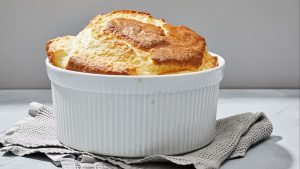
Cheddar-based soufflé (The Washington Post)
-
US, England: cheddar, often combined with ham or bacon.

Herbed Manchego cheese soufflé with onion pear jam (Ma niche)
-
Spain: manchego.
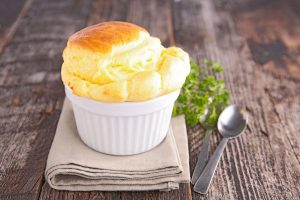
Soufflè al formaggio (Cookist)
-
Italy: soufflé di formaggio, 4-cheese soufflé (fontine, bel paese, parmesan, emmental), gorgonzola, mascarpone (sweet soufflé)

Japanese-style souffle cheesecake (Catherine Zhang)
- Japanese soufflé cheesecake: this is a cheesecake made with a meringue base. This combination of two different desserts sounds so unique and delicious!

La Chapelle 1733
History of the Cheese Soufflé
The cheese soufflés as we know and love today appeared in the 18th century by the French master cook, Vincent de la Chappelle, who, among various European dignitaries cooked for Madame de Pompadour, mistress of Louis XV and wrote the modern cookbook. It really took off and gained the height of popularity in the mid-1800s when the French chef Antonin Carême, who was cooking for royalties and the newly rich in Paris, was aided by the improved ovens that were heated by air drafts rather than coal. In the 1850s, the frozen soufflés made their first appearance since the classic hot ones were deemed unappetizing during summer.
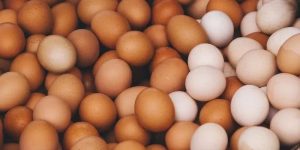
Fresh farm eggs
How Many Eggs Should We Eat per Day?
As you are now aware, the creation of a soufflé is impossible without eggs. You would have no puffy consistency, no airy texture, and no delicious experience. That being said, how often should one consume eggs?
According to the Mayo Clinic Health System and Harvard University, an egg contains roughly 75 calories, 1.5 grams of saturated fat, and 210 milligrams of cholesterol. They are a great source of vitamins A, D and B12, as well as choline, a nutrient that plays an essential role in one’s metabolism. Except for its cholesterol content, one egg is a healthy option for breakfast, lunch or dinner.
Research shows that the liver is stimulated to make cholesterol primarily by saturated fat and trans fat in our diet, not dietary cholesterol. Thus, the cholesterol in eggs doesn’t seem to negatively affect the human body compared to other sources of cholesterol. For example, eggs are typically eaten with other foods high in salt and high in saturated fat, such as bacon, cheese and butter. These foods may increase heart disease risk and should be eaten sparingly.
Most healthy people can eat up to seven eggs a week without affecting their health. Some choose to eat only the egg white and not the yolk, which provides some protein without the cholesterol.
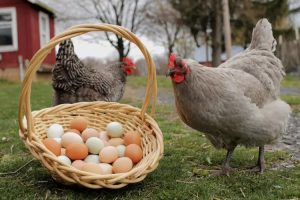
Chickens and an egg basket (The Spruce)
Pasture-Raised Hens, Organic Hens, or Conventional Hens: Which Eggs Are Best for You?
You might have also noticed that there are so many different labels on egg cartons in supermarkets: organic, free-range, cage-free, pasture-raised … What does all this mean, and which kind is the healthiest?
-
Conventionally-Raised:
This is how most eggs are produced. Chickens live together by the thousands in very tight spaces, often in cages that are only as big as the chickens themselves. They never go outside or search for bugs and insects to eat. Due to these constrained conditions, their eggs may contain harmful bacteria and are washed with chlorine and lye to disinfect them before being sold. - Organic: This designation means that the chickens’ food must be grown with no synthetic fertilizers or pesticides and that they must have access to the outdoors, at least occasionally (Note that the “cage-free” label doesn’t necessarily mean that they free-roam outdoors. They are often still raised inside buildings). While these conditions are better than the industrial conventional way, their eggs are not free from bacteria and are also washed before selling.
-
Pasture-Raised:
This method has the highest standard for the chickens’ living conditions, the eggs they lay, and therefore for the consumer. They are raised outside and frequently moved to new pastures so they can easily find new insects, seeds, and worms to eat.
According to Penn State’s College of Agricultural Sciences research, eggs from pastured hens had twice as much vitamin E and long-chain omega-3 fats, more than double the total omega-3 fatty acids, and less than half the ratio of omega-6 to omega-3 fatty acids compared to eggs from the commercial hens. The Vitamin A concentration was 38 percent higher in the pastured hens’ eggs than in the commercials’, but the total vitamin A per egg did not differ. A Mother Earth News study also revealed that pasture-raised eggs have major advantages over regular commercial eggs.
In 2021, CBC Marketplace made laboratory tests of various egg types and did not find major differences in their nutrient values. Their main findings were that the organic eggs did have higher omega-3 levels compared to their conventional counterparts. Also, they found that small-farm organic eggs had more nutrients.
Now that you know all about eggs and cheese soufflé, we hope you will feel like biting into this soft, airy, and cheesy dish! And if you feel like making one yourself, you will know which eggs are the healthiest and the most ethical to use!




